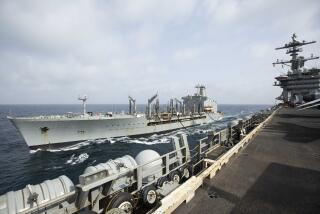Ship Deaths at 28; Iraq, Iran Warned : Reagan Also Heightens Gulf Alert; at Least 15 Others Injured on Frigate
WASHINGTON â The death toll Monday rose to 28 aboard the U.S. Navy ship struck by an Iraqi missile, and President Reagan ordered other American vessels in the Persian Gulf to a higher state of alert, warning Iraq and Iran that their planes will be fired on if there is a hint of hostile intent.
Twenty-four hours after the Stark, a guided missile frigate, was hit by an Iraqi air-to-sea missile streaking out of the darkness, firefighters still struggled to contain sporadic blazes on the ship.
Pentagon officials said that as many as 15 members of the shipâs crew were injured in the inexplicable attack launched by a Mirage F-1 jet. Some of the injured had been treated aboard ship and returned to duty as the heavily damaged Stark struggled toward port in Bahrain, officials added.
White House Angered
The tragic incident in the oil-rich gulf, where Iran and Iraq continue to fight in an escalating seven-year conflict, infuriated Reagan Administration officials, although the Pentagon has characterized the attack as accidental.
Reagan met with the National Security Planning Group at the White House for an hour and 15 minutes Monday afternoon, then ordered the higher state of alert for the six other U.S. warships in the gulf.
A White House statement said that Iraq and Iran were notified that âaircraft of either country flying in a pattern which indicates hostile intent will be fired upon unless they provide notification of their intentions.â
After demanding an Iraqi explanation in diplomatic messages delivered in Washington and Baghdad, the White House said that the United States also expects âan apology and compensation for the men who died in this tragic incident,â plus compensation for the 3,740-ton, 453-foot-long frigate.
Iraq Accepts Blame
On Monday night, Iraq formally accepted responsibility for the missile attack, calling it an âunintentional incident.â
The episode, the first spillover of violence from the Iran-Iraq conflict to affect a U.S. Navy vessel, took an unexpected turn Monday afternoon with the disclosure that the Stark twice tried to warn the approaching Iraqi plane away.
Were Aware of Radar
Officials said that the Stark had become aware that the warplaneâs targeting radar had locked on to the ship before the plane fired an Exocet missile. Launched from a range of 11 or 12 miles, the missile struck the ship within 1 or 1 1/2 minutes, ripping a 10-to-15-foot hole in its hull just above the waterline.
Officials said they could not explain why the ship did not use its Phalanx anti-missile system, which is designed to intercept cruise missiles such as the Exocet as they streak low over the water at about 600 m.p.h.
âProtested in Strongest Termsâ
The President, describing himself as concerned and angry, promised a report to the nation on the attack as soon as its circumstances are clear. âWe have protested this attack in the strongest terms and are investigating the circumstances of the incident,â he said.
At the State Department, spokesman Charles Redman reiterated that âwe view this unprovoked attack with the utmost seriousness, and weâve demanded a full accounting and explanation of the attack. We expect an immediate response.â
White House spokesman Marlin Fitzwater said that Iraqi Ambassador Nizar Hamdoun had âexpressed profound regretâ over the tragedy and had called for a âcomplete investigation.â
In a message to Reagan more than a day after the raid, Iraqi President Saddam Hussein said that the warplanes âhad no intention whatsoever to strike at a target belonging to your country or to any country other than Iran.â
Other Activity in Area
Hussein said that Iraqi warplanes previously had aimed at âenemy targetsâ in the area in which the Stark was hit by missile fire.
Before the U.S. ship was hit Sunday, Iraqi warplanes attacked two tankers about 60 miles north of the position where the Stark was hit, about 85 miles northeast of Bahrain. The Stark was hit about 10:10 p.m. local time (11:10 a.m. Sunday PDT).
As more details of the attack emerged Monday, the Pentagon stood by its judgment that the pilot of the Iraqi plane mistook the American ship for an Iranian vessel or for one of the tankers attacked by Iraqi planes hours before the Stark was hit.
âIt is not inconceivable that the pilots coming out at night could have become confused and made a navigational error and attacked this ship, which could look somewhat the same to the airplaneâs radar,â said Vice Adm. Henry C. Mustin, a deputy chief of naval operations for the Joint Chiefs of Staff.
Number of Jets Uncertain
Initially, the Pentagon officials said that two Iraqi planes were involved in the attack, each firing one Exocet from a position over the horizon from the ship. On Monday, they said it appeared that the attack was launched from a distance of only 11 or 12 miles, but it was still not certain whether one or two planes took part.
Air Force Lt. Gen. Richard A. Burpee, director of operations for the Joint Chiefs of Staff, said that radar--apparently airborne warning and control system (AWACS) on planes over Saudi Arabia--tracked one plane, possibly two, flying from Iraq southward along the Saudi Arabian coast in the gulf about 10 minutes before the attack.
âIt turned east, and something like 11 or 12 miles out from our ship, it fired a missile,â he said. âAnd, of course, the missile went in the left-hand side--the port side of our ship--at somewhere just above the waterline. . . .â
âWe donât know why this occurred. The ship, our ship, was operating clearly in international waters. We did not suspect any hostile intent. We had no reason to believe there was hostile intent from Iraq.â
Also, Burpee said, Iraqi warplanes rarely operate as far south as the location of the attack Sunday.
Details Sketchy
Details from the stricken vessel remained sketchy late Monday.
Officials said that Cmdr. Glenn R. Brindel, the Starkâs commanding officer, was âstill pretty busy fighting firesâ and âthe last thing he needs is somebody from Washington to bother him while heâs in an extremely tense situation.â
âThe captain is mustering his crew now,â Adm. Mustin said at a Pentagon press conference Monday afternoon. âItâs dark, thereâs a lot of confusion on the ship; itâs taken serious damage.
âHeâs had to open hatches because the interior is full of smoke. The routine means of communication, loudspeakers and telephones, have been disrupted.â
Standard operating procedures call for U.S. warships to operate at a heightened state of readiness while on patrol in the tense gulf, where the Iran-Iraq War has raged for seven years.
At the time of the attack, the Stark crew was apparently on Readiness Condition 3, meaning that about a third of its crew of 231 were at their stations, with all of the vesselâs weapons systems manned.
Automatic Response
The Phalanx system is capable of fully automatic response to attack by the Exocet and other cruise missiles, but Pentagon officials did not say whether the rules of engagement followed while patrolling the gulf called for the system to be in the automatic mode of operation.
They acknowledged, however, that there was time for the ship to have responded if it had recognized that it was under attack. They repeatedly declared that they could offer no explanation why it had not reacted.
The Exocet missile, still carrying much of its propellant because of its short flight toward its target, penetrated the armored hull below the deck level in the area of the shipâs berthing facilities.
A fire was put out in the berthing area Monday, but officials said they could not confirm whether that was where most of the casualties occurred.
The latest complication in the tinderbox gulf area came as the United States considered increasing its presence by lending American flag protection to Kuwaiti tankers.
Even before Reagan ordered a heightened state of alert in the gulf, Pentagon officials said that the attack on the U.S. frigate would bring a review of U.S. deployments and rules for engagement in the area.
Times staff writer Charles P. Wallace in Bahrain contributed to this story.
More to Read
Sign up for Essential California
The most important California stories and recommendations in your inbox every morning.
You may occasionally receive promotional content from the Los Angeles Times.









